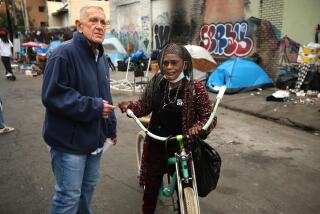The Nation : HOMETOWN U.S.A.: Plains, Ga. : Carter’s national historic gas station?
In the age of the $787-billion stimulus package, it is, perhaps, a modest question:
Should the American taxpayer foot the bill to enshrine the gas station run by the late Billy Carter -- the beer-swilling, wisecracking, self-professed redneck brother of our 39th president?
Located in the middle of tiny Plains -- still the world’s most famous peanut town some 28 years after the Carter presidency -- the station was transformed into a museum last year by a civic group that owns the property.
Most locals agree it has been rendered cleaner and more pleasant than it was under Billy’s proprietorship, when it served as an improvised beer joint, gambling hall and grease-stained agora for homespun philosophizing.
Its claim to historical significance came during Jimmy Carter’s 1976 presidential run, when reporters mobbed Plains and transformed the station into a sort of unofficial headquarters.
It became the setting for story after story about Jimmy’s little brother, Billy, his down-home manners and epigrammatic wit (e.g., “Beer is not a good cocktail-party drink -- especially in a home where you don’t know where the bathroom is”) and the candidate’s rural roots.
In a reminiscence posted at the museum, Billy’s family writes that both press and tourists back then “seemed to be amazed a place such as the Station actually existed outside bad, B-grade movies about Southern moonshine runners.”
Last month, the House approved a measure that would incorporate the station into the Jimmy Carter National Historic Site, a National Park Service operation that runs a number of Carter-related buildings in Plains. A similar bill is under consideration in the Senate’s Energy and Natural Resources Committee.
The legislation calls for the park service to take over the gas station, plus an old farmhouse that Jimmy and wife Rosalynn lived in from 1956 to 1961. Both would be donated by the current owner, the Plains Better Hometown Program.
The park service would also take over a state-run welcome center on the edge of town that has been threatened with closure because of state budget problems.
The Congressional Budget Office estimates that it will cost $17 million to upgrade and maintain the sites over the next five years.
That was enough to elicit an objection from Steve Ellis, vice president of the Washington-based Taxpayers for Common Sense.
Ellis said his concern has nothing to do with Billy Carter’s place in history. It’s a question of priorities, he said. The park service already faces a $9-billion maintenance backlog for the property it currently manages, according to the Congressional Research Service.
The gas station is “not in imminent danger of being turned into condos or something like that,” Ellis said. “So you’ve got to question whether it’s the best move for the park service.”
Somewhat unsurprisingly, the idea is more popular in Plains (population 630). “I think Billy Carter was very much a part of the story of President Carter growing up in a small town,” said Sandra Walters, 70, who lives next door to President Carter’s modest compound and has known the family for years. “[Billy] wasn’t in the Cabinet, but he was a big part of Jimmy Carter’s growing up.”
There is grumbling, from time to time, about the special status Jimmy Carter has bestowed on his hometown. The federal government has declared all of downtown Plains a preservation district, which subjects property owners to certain building restrictions.
But for the most part, locals have come to embrace living in this strange mix of working agricultural hub and shrine to a native son.
Of course, Carter, 85, and his wife, 82, still live here, and the chance to glimpse them cycling around town, or to catch one of his Sunday school lessons at Maranatha Baptist Church, is part of the town’s allure.
Speaking about the inevitable end of the Carters’ lives tends to make people uncomfortable. The Carters are neighbors, after all. But the park superintendent, Gary Ingram, reluctantly conceded that this is one reason he supports the bill: The historic site, he said, will need to offer new enticements to visitors once the Carters pass away.
“The Billy Carter piece is just one little tiny component of the thing,” he said. “It’s a spur, but it’s a spur that still has relevance because it’s connected to the larger story.”
That relevance is already on display inside the tiny gas station, where there are the requisite artifacts of the man as media caricature -- but also poignant reminders that such roles can exact a toll.
Stacked on a shelf are orange-labeled cans of Billy Beer, the short-lived commercial venture Billy briefly endorsed. There are a few mannequins decked out in classic Billy gear: croc-print Justin boots, red-white-and-blue Carhartt overalls, a polyester racing jacket.
There are also references to “Billygate,” the embarrassing episode in which the little brother admitted accepting a $220,000 loan from Libya, apparently to help its radical government broker oil deals.
In a drawer, there is a statement he wrote out by hand during his well-publicized -- and successful -- struggle to quit drinking: “I’m Billy Carter and I am an alcoholic. For several years . . . probably the most public drunk in America.”
A gracious letter from Johnny Cash wished Billy well as he battled the cancer that would eventually kill him in 1988.
On a recent visit, the building was unlocked and unattended.
Hundreds of visitors had signed the guest book.
“I like Jimmy,” one of them wrote. “But Billy’s museum is way more interesting.”
--
More to Read
Sign up for Essential California
The most important California stories and recommendations in your inbox every morning.
You may occasionally receive promotional content from the Los Angeles Times.










